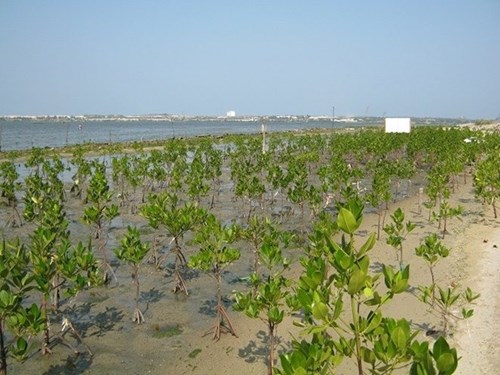Speaking at the workshop, Nguyen Duy Tuan, Director of the Institute of Geology, Water and Environment, said that responding to climate change, especially in the Mekong Delta, was a top national priority.
“It’s vital to seek solutions and invest in new structures to prevent tides and saline intrusion. We also need to store fresh water and respond to rising sea levels in the Mekong Delta, as well as cope with flooding in HCM City,” he said.
The Vung Tau-Go Cong sea dyke project, which was proposed in 2011 by the Ministry of Agriculture and Rural Development, would include a 28km-long main dyke extending from Go Cong Commune (Tien Giang province) to a point 5 km from Vung Tau City (Ba Ria-Vung Tau province), where it would connect with another dyke 13km long running to Can Gio Biosphere Reserve in Ho Chi Minh City.
    |
 |
|
Photo for illustration. Source: dmhcc.gov.vn |
The project would also include construction of the Long Tau sluice, and canals North of the Soai Rap River.
According to Tuan, scientists have completed a pre-feasibility study for the project, which has met the requirements of HCM City and Mekong Delta provinces.
To set up a scientific basis for the construction of the Vung Tau-Go Cong sea dyke, the Ministry of Science and Technology has launched six independent scientific research projects at the state level.
Prof., Dr. Dao Xuan Hoc, Chairman of the Vietnam Irrigation Association, said the sea dyke project would offer a solution to flooding caused by a combination of heavy rains and tides. It would also address salinity intrusion and rising sea levels for 1.1 million hectares.
“It is recommended that the project be implemented in three phases with a total investment of VND 74 trillion (USD 3.24 billion),” he said.
Dr. Le Xuan Tuan of Hanoi University of Natural Resources and Environment said it was important to continue to assess floods, tides and mangrove forests and other natural phenomena West of Long Tau River and East of Soai Rap River.
He explained that the assessment would serve as a basis for a more detailed assessment of the impact of the Vung Tau – Go Cong sea dyke construction on the area’s ecosystem, especially on mangroves and benthic animals.
Experts at the workshop also discussed the possible impact of the project on social and economic development of localities, as well as the development of waterway transport in the region.
The workshop was organized by the Institute of Geology, Water and Environment, Vietnam Irrigation Association, Vietnam Hydrological Association and the Hoang Gia Water and Environment Joint Stock Company.
Source: VNA